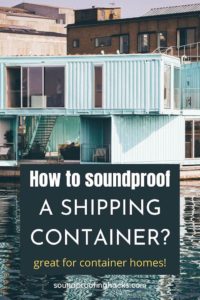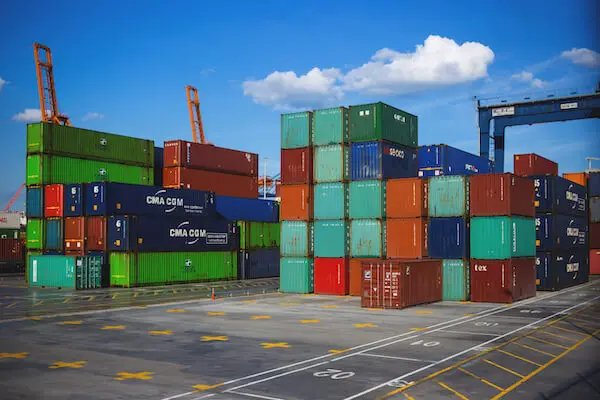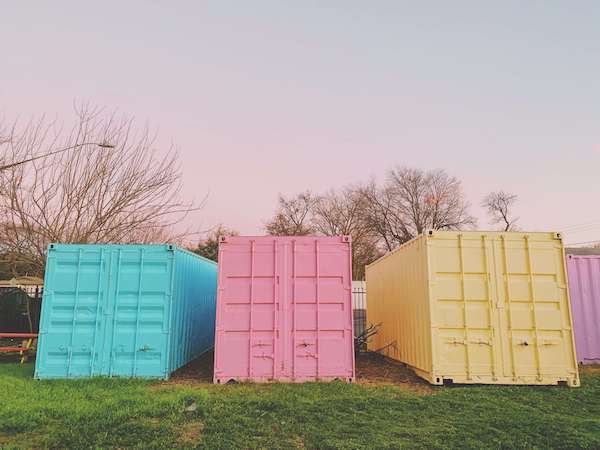How To Soundproof A Shipping Container? 4 Easy Steps
I remember watching an interesting program a couple of years ago about tiny homes. It struck me how you can actually build a beautiful and comfortable living space with so little to work with. As I got hooked on the series, it seems that lots of these homeowners have opted to buy shipping containers and turn them into their residence.

That got me thinking, wouldn’t it be very noisy? In the back of my mind, I was thinking that these huge metal boxes would be conductors of noise, so how do they live in it? For a long time, I kept thinking about how to soundproof a shipping container, or if it is possible at all.
I finally got my chance, as a friend of mine recently bought a shipping container and wanted to turn it into a mini vacation home for him and his wife.
He knew I loved this kind of stuff, so he enlisted my help with this soundproofing project.
Read on to find out how you can soundproof a shipping container!
I am an Affiliate for Amazon and others, which means I may make a commission if you purchase something through the links here. There is NO extra cost to you at all, and THANK YOU so much for the support. Learn more here.
Contents: Skip to section
What are the uses for shipping containers?
Today, you may see more shipping containers around your local neighborhood than at the port.
These iconic containers are now used as houses, offices, motel rooms, cafes, businesses, music studios, shops and even daycares.
You may be interested in purchasing a shipping container for many reasons, but regardless of your goals, insulating and soundproofing are the most popular first step.
How large is a standard shipping container?
Standard shipping containers are either 10 feet, 20 feet or 40 feet long, and are all typically 8 feet wide and 8.5 feet tall.
The most common standard shipping container size is 20 feet long, with an area of 320 sq/ft externally, and 256 sq/ft of space on the inside of the container.
Shipping containers can come in many different sizes, and you can find more information on different sizes and features here.

What you should know before buying a shipping container: A few tips
My friend has kindly given me a few tips he picked up while searching for a container. Here you go:
- Try searching on Craig’s List or eBay for budget friendly gems
- Consider getting a used container to save even more
- Look for containers that are built with Cor-Ten steel. They last the longest and can withstand the elements very well
- Check ahead of time to find out if your insurer can cover your new toy
- Avoid pre-fab containers. You are likely going to spend more money reconfiguring them
How much do shipping containers cost?
Spaces made from shipping containers are popular as they save money on maintenance and energy.
A regular shipping container can cost as little as $500 for a used, non-serviceable container, but can cost up to $5,000 for new, serviceable containers.
On average, DIY shipping container projects that are smaller can be anywhere from $5,000 to $30,000.
If you are looking to do a larger, multi-container project, this can cost up to $100,000.
Things that you will also want to consider are other costs you may need to pay, such as delivery, site preparation, any required permits, container cleaning, flooring, insulation, utilities, installation of windows or doors and others.
Check out this article for a rough guide on the available ways to rent or purchase a container for your home.
Hey, quick one. If you intend to start a soundproofing project soon, check out our Best Materials for Soundproofing post to get a headstart. Most projects require similar materials, so this post will save you a ton of time researching.
Can you soundproof a shipping container?
You know the saying “empty vessels make the most noise”? Yea, shipping containers are kind of like that.
Shipping containers are made of a thin layer of steel, so they are not very good at keeping sound either in or out.
Steel vibrates sound energy, which allows sound to travel through it easily, making noises on the inside both echo and travel, and external noises like rain amplify.
But don’t worry, it is possible to soundproof a shipping container and create a comfortable environment inside. If you are paying attention to the saying above, you know that vessels make a lot of noise only when empty, so your job will be to fill it up.
By soundproofing your shipping container, you are reducing noise from both inside and out.
Plus, by insulating your shipping container, you are also minimizing the transfer of temperature, which can reduce your energy use and increase your efficiency.
Check out an article on container sustainability benefits here.
Most people choose to insulate the inside of their container, as external insulation projects usually require professional help.
Soundproofing the inside of your shipping container can be an easy, low-cost DIY project.
Before beginning, it is important to plan out your budget and your goals for the insulation.
How to soundproof a shipping container: 4 simple methods
There are many options when soundproofing your shipping container, here I discuss the best materials that are the most effective, the easiest to install, and the cheapest, of course!
1. Interior wall framing
The most effective insulation method for your shipping container is by installing interior walls.
Stud walls can be added to the interior of containers to create a layer of internal insulation, but this may require some more technical guidance or assistance.
By installing ceiling and wall boards to the inside of your container, you are creating a much more soundproof environment.
Walls in your container also create space for plumbing, electrical and other utilities to be stored away from plain view.
There are many different types of wall insulation and different ways to install the framing and walls to your container, such as using plywood.
2. Blanket insulation
One of the more popular options for soundproofing a shipping container is blanket insulation.
Blanket insulation comes in rolled pieces of thick, fluffy blanket material that you can order pre-sized or cut yourself during your project.
Blanket insulation works well due to its material that has many fibers, and it is very easy to install yourself.
It is installed by simply sticking the material to the corrugated areas in your container, or by stapling or glueing it to insulated studs.
Here’s a good resource on insulated studs.
Check out the different kinds of blanket insulation you can use for your container:
- Fiberglass Insulation
- Mineral Wool
- Cotton Insulation

3. Foam board insulation
Another great type of insulation to soundproof your container is foam board insulation.
Expanded foam is always a great choice for your container, as it can be ordered in pre-sized panels, and requires no support to hold up.
Expanded foam panels can be glued or attached by other adhesives right to the steel layer of your container.
There are many types of foam insulation that you can choose from, and they are one of the cheapest materials with the highest soundproof quality.
Plus, the sound reduction quality of foam panels may last up to 20 years.
4. Spray foam
My favorite, an easy and effective way to soundproof your container yourself is with spray foam.
Polyurethane spray foam insulation is applied by industrial can, and is the easiest type of insulation to use.
Spray foam insulation turns from a liquid spray to a solid barrier that grows and sticks to the surface.
It creates a uniform wall that blocks sound and also reduces the transfer or hot or cold air.
Spray foam requires no framing and will instantly create a sound barrier inside your container.
To learn the tricks and benefits of spray insulation, check out what Ultimate Radiant Barrier & Insulation have to say.
Read more: How to soundproof wooden floors using 3 simple methods
5. Moving blankets and soundproof curtains
This step is optional, but will be highly beneficial to those who are using shipping containers as homes.
Hang moving blankets or soundproof curtains around your windows or doors to enhance the soundproofing capabilities of your tiny home.
They can also be used on your walls too.
They are friendly to the wallet, yet highly effective.
Recommended tools/materials
Fibreglass Insulation
Mineral Wool Insulation
Foam Board Insulation
Spray Foam Insulation
Tips to remember
Always keep your home climate in mind when insulating your container, as the environment you live in may change decisions you make for your container project.
You can always consult a contractor if your project becomes complicated or it becomes hard on your DIY abilities.
Having a budget and a clearly defined project will help you to manage your shipping container project and succeed in your soundproofing.
Frequently Asked Questions (FAQ)
What is the best way to insulate a shipping container?
The most common, affordable and DIY-friendly insulation method is spray foam, but the most effective insulation method is installing internal walls to your container.
Are container homes noisy?
Without insulation, shipping containers only have one steel wall which makes sound inside the container echo.
It can also become very loud inside your container because of external events such as rain.
With proper insulation, container homes can be a quiet and peaceful space.
How much does one shipping container cost?
The cheapest used containers will be $500 – $2,500, while new containers that have higher quality assurances will cost anywhere from $5,000 – $7,000.
Having a container delivered to your home costs on average $1,000, but varies based on how far the container has to be shipped, so finding a local container retailer will reduce your delivery fee.
How much does one shipping container cost?
Building or contracting a container home can vary in cost because of many factors unique to your project, but on average for a smaller, one-container home you can pay as little as $5,000 up to $30,000.
Other interesting reads:




